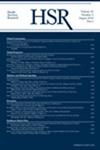The impact of Medicaid expansion on state expenditures through the COVID-19 era
Abstract
Objective
To investigate the impact of Medicaid expansion on state expenditures through the end of 2022.
Data Sources
We used data from the National Association of State Budget Officers (NASBO)'s State Expenditure Report, Kaiser Family Foundation (KFF)'s Medicaid expansion tracker, US Bureau of Labor Statistics data (BLS), US Bureau of Economic Analysis data (BEA), and Pandemic Response Accountability Committee Oversight (PRAC).
Study Design
We investigated spending per capita (by state population) across seven budget categories, including Medicaid spending, and four spending sources. We performed a difference-in-differences (DiD) analysis that compared within-state changes in spending over time in expansion and nonexpansion states to estimate the effect of Medicaid expansion on state budgets. We adjusted for annual state unemployment rate, annual state per capita personal income, and state spending of Coronavirus Relief Funds (CRF) from 2020 to 2022 and included state and year fixed effects.
Data Collection/Extraction Methods
We linked annual state-level data on state-reported fiscal year expenditures from NASBO with state-level characteristics from BLS and BEA data and with CRF state spending from PRAC.
Principal Findings
Medicaid expansion was associated with an average increase of 21% (95% confidence interval [CI]: 16%–25%) in per capita Medicaid spending after Medicaid expansion among states that expanded prior to 2020. After inclusion of an interaction term to separate between the coronavirus disease (COVID) era (2020–2022) and the prior period following expansion (2015–2019), we found that although Medicaid expansion led to an average increase of 33% (95% CI: 21%–45%) in federal funding of state expenditures in the post-COVID years, it was not significantly associated with increased state spending.
Conclusions
There was no evidence of crowding out of other state expenditure categories or a substantial impact on total state spending, even in the COVID-19 era. Increased federal expenditures may have shielded states from substantial budgetary impacts.

 求助内容:
求助内容: 应助结果提醒方式:
应助结果提醒方式:


